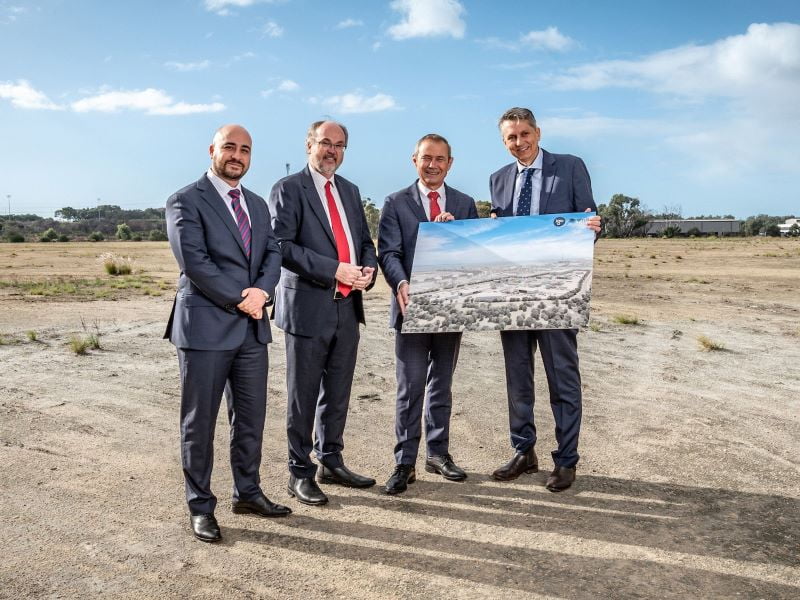Critical minerals ventures in Western Australia, Queensland and New South Wales have shared in nearly $50 million in federal grants to help diversify supply chains, increase value-add and lower emissions.
Projects received up to $6.5 million to improve the mining, refining and production of critical minerals for batteries, advanced manufacturing, solar cells and electronics.
The round includes an ambitious project steered by Andrew Forrest to move Australia further down the battery value chain with a new plant that makes the precursor material for the cathodes in modern batteries.

Announced on Thursday, the funds come from the Albanese government’s Critical Minerals Development Program, which takes the lead from a similar Coalition-era industry support program but adds new diversity and inclusion requirements.
Early last year, the then-Coalition government announced a $200 million Critical Minerals Accelerator Initiative. A quarter of the grants were controversially awarded in a closed round with only select companies invited to apply.
The new government slimmed down the remaining grants to $50 million but kept a research hub initiative and committed to refresh the Critical Minerals Strategy, which is expected to be released in coming months and detail how the nation can capture more of the booming global market.
In this month’s federal Budget, the government committed another $80.5 million to support the local critical minerals sector, with the bulk of the funding going to promoting Australia in global markets and local policy development.
“Australia has remarkable potential to meet the increasing global demand for the critical minerals needed for clean energy technologies, such as electric vehicles and batteries, as the world moves to decarbonise,” Minister for Resources and Northern Australia Madeleine King said in a statement on Thursday.
Most of the projects and grants went to Western Australia, including to a mining firm partnering with Andrew Forrest to build a Nickel-Cobalt Refinery at Kwinana in southern Perth.
The firm, IGO, received $4.6 million from the Critical Minerals Development Program, which can contribute up to half of eligible project expenditure.
The IGO project, in partnership with Mr Forrest’s Wyloo Metals, is aiming to produce high-value nickel dominant precursor cathode active material – a key part of the chemical mix that goes into the lithium-ion batteries powering most electric vehicles. It has forecast capital expenditure between $600 million and $1 billion.
Wyloo and IGO announced plans for the refinery after securing land from the state government in April, just days after Ms King sent another signal the government wants to ramp up critical minerals processing and ultimately battery assembly.
According to the company, the new grant will allow it to complete “piloting, metallurgical test work, a demonstration phase feasibility study, a by-product optimisation study and detailed engineering for the development of an Australian-first Integrated Battery Material Facility”.
Other Western Australia projects to receive grants are:
- $5.5m to Australian Energy Storage Solutions for a pilot to set up Australia’s first Precursor Cathode Active Material manufacturing plant in Kwinana
- $1.2m to Tungsten Metals Group for the production of Ferrotungsten Powders for advanced manufacturing for aerospace, medical, energy and defence products
- $4.7m to International Graphite to support the International Graphite WA Mine to Market Battery Graphite Materials Project
- $5.9m to Northern Minerals to support its Browns Range Heavy Rare Earths Project at Halls creek
- $1m to Tungsten Mining to support test work for its Mount Mulgine Tungsten Project
- $6.25m to Magnium Australia to commercialise CSIRO-patented technology for clean extraction of magnesium metal, and a Magnesium Refinery Pilot Plant in Collie
Three New South Wales project received funding:
- $6.5m to Australian Strategic Materials for its Dubbo Project, to support mining, separation and refining, and production facility for critical minerals including neodymium, praseodymium, dysprosium, terbium, zirconium, niobium, and hafnium
- $2.0m to Clareville for testing and scale up on its novel flotation separation additive which increases recovery of key critical minerals, such as lithium, cobalt and vanadium, by 50 per cent — with no increase in carbon emissions or environmental impacts
- $2.9m to Ecograf to support a graphite qualification facility at Lucas Heights
Another three projects in Queensland received funding, including a refinery and mine recycling initiative:
- $5m to Queensland Pacific Metals for the engineering and design for phase one of a full-scale refinery for its Townsville Energy Chemicals Hub
- $1.2m to High Purity Quartz to support a pre-feasibility study for a project to build a solar PV grade quartz sand processing facility and a silicon metal production facility to establish solar PV cell manufacturing in Townsville
- $2.2m to Evolution Mining to support Ernest Henry Operations to retrieve cobalt from mine waste
“The 13 projects to receive funding under the Critical Minerals Development Program grants include plans to produce key inputs to lithium-ion batteries for electric vehicles, and to support supply chains for advanced manufacturing for aerospace, medical, energy and defence applications,” Ms King said.
“The grants will support Australia’s new Critical Minerals Strategy, to be released shortly and which will outline how Australia can capture the significant opportunity of growing its critical minerals processing sector.
“Australia has remarkable potential to meet the increasing global demand for the critical minerals needed for clean energy technologies, such as electric vehicles and batteries, as the world moves to decarbonise.”
Do you know more? Contact James Riley via Email.

